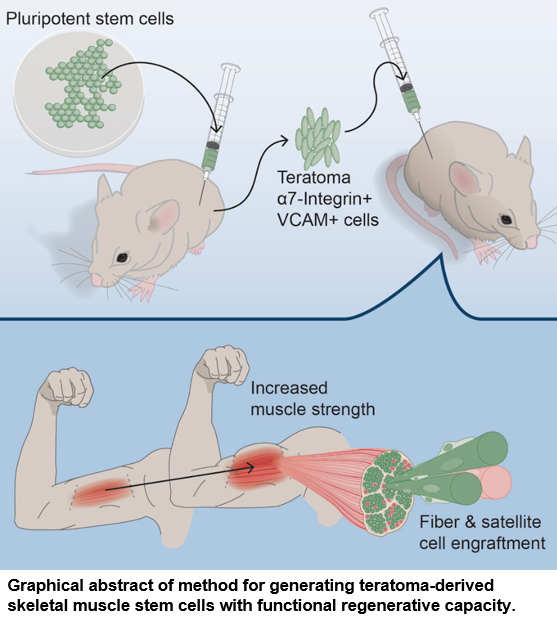Generating teratoma-derived skeletal muscle stem cells
A method for generating teratoma-derived skeletal muscle stem cells with functional regenerative capacity.

Applications
- Regenerative therapy
- Research tool
Key Benefits & Differentiators
- Regenerative potential: Teratoma-derived skeletal muscle stem cells have comparable regenerative potential to human skeletal muscle stem cells (satellite cells)
- High potency: Potency of teratoma-derived cells is greater than that of conventional methods used to generate skeletal muscle stem cells
Technology Overview
Muscular dystrophy (MD) is a group of hereditary diseases characterized by progressive weakness and loss of muscle mass. MD affects about 250,000 people in the United States. Regenerative medicine offers promise in the treatment of MD. However, the inability to derive transplantable skeletal muscle stem cells from wild-type pluripotent stem cells hinders this promise. New approaches are needed to turn pluripotent stem cells into a viable regenerative therapy for MD.
Researchers at the University of Minnesota have developed a method for generating teratoma-derived skeletal muscle stem cells with functional regenerative capacity. This method involves injecting pluripotent stem cells into an immunodeficient mouse, allowing one or more teratomas to form, and isolating skeletal muscle stem cells from one or more teratomas using a novel antibody cocktail. Following the injection of as few as 40,000 teratoma-derived skeletal muscle stem cells into a tibialis anterior muscle of diseased mice, approximately 80% of the muscle volume is reconstituted. Newly generated muscle fibers are innervated, express adult myosins, and significantly improve dystrophy-related force deficit and fatigability. Teratoma-derived skeletal muscle stem cells also contribute to quiescent muscle stem cells, enabling long-term maintenance of regenerated muscle and allowing muscle regeneration in response to subsequent injuries. This method for generating teratoma-derived skeletal muscle stem cells can potentially be used for regenerative therapy development and as a research tool for studying muscle diseases.
Phase of Development
TRL: 4-5Method for generating teratoma-derived skeletal muscle stem cells has been successfully demonstrated in mice.
Desired Partnerships
This technology is now available for:- License
- Sponsored research
- Co-development
Please contact our office to share your business’ needs and learn more.
Researchers
- Michael Kyba , PhD Professor, Department of Pediatrics
- Sunny Chan , PhD Assistant Professor, Department of Pediatrics
-
expand_more library_books References (1)
- Sunny Sun-Kin Chan, Robert W. Arpke, Antonio Filareto, ..., Jacqueline S. Penaloza, Rita C.R. Perlingeiro, Michael Kyba (July 05, 2018), Skeletal Muscle Stem Cells from PSC-Derived Teratomas Have Functional Regenerative Capacity, Cell Stem Cell, 23, 74-85
-
expand_more cloud_download Supporting documents (1)Product brochureGenerating teratoma-derived skeletal muscle stem cells.pdf